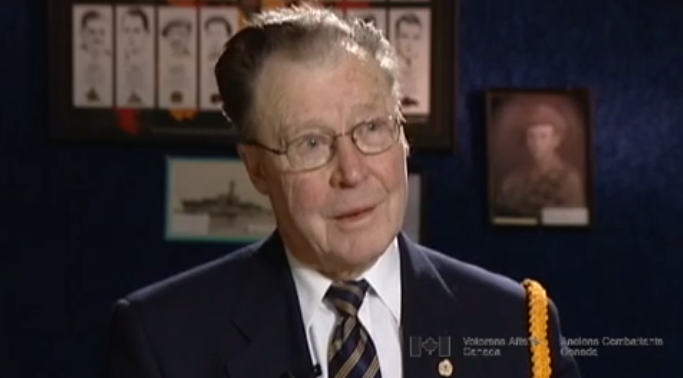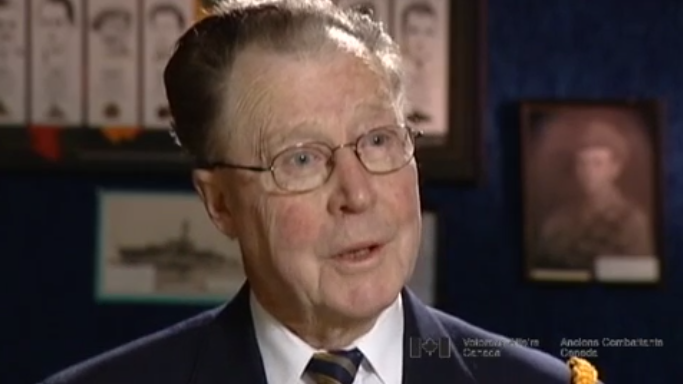I had a, a nice experience. I guess it was a nice experience,
about the third day in Sicily, and it was so new, we were all so
new and that yet that.... I know now, we were getting mortared
‘cause we were right up... I could see, you could see, the
Germans. And this, there were explosions going on here and
there. It was stuff coming over the hill, right around us. And
it's funny, you'd think training would do you any good, but for
some reason, I run like hell from where I was. There was a, a
culvert in the road, and the culverts there... it was, it was
all hilly in Italy, little dips. It was this little culvert
there, and culverts there were stone, and about three feet, four
feet high, and a ditch down into the front of them. I was going
the hell into there, and everyone was running into there. You
could hear them mortaring. You could hear them and they're kind
of slow coming. You hear the whistling coming towards you. There
was lots of that going on, but there's one particular one,
landed and blew the front end off of a, of an English car
sitting that was where I was, but I wasn't there any more ‘cause
I'd run from that noise to get into that culvert, and I hurt
myself. I'd pulled my nose up. I was bleeding pretty bad on
somebody, so get me in that hole, under that culvert. But they,
that's the real, first real shelling I ever experienced. And
they blew the end of the, the other end of the culvert shut.
That's how much close it was there, but blew it shut, anyways.
And... some of them Seaforth boys, I was there, but some of them
Seaforth boys had them shovels with their kits, dug that thing
out, and Montgomery was in the other end of the tunnel.
Montgomery. And I wondered what in hell would Montgomery be
doing up there. There was a jeep come around for a drive, an
English driver, who's all British 8th Army, and Montgomery,
myself and another guy, he took us back behind the lines to... I
don't know what the hell for. But I remember me sitting in the
back of the, the back of this jeep, and he was, Montgomery was
in the front right, and he offered us a smoke, and I thanked him
and I didn't take one, and I was so embarrassed, and I said
something to him about I'm not a very good soldier ‘cause I was
shaking so bad. And he said, remember him saying to me, "It's
OK, laddie. It was a harrowing experience." That's Englishmen.
And he's so calm, nothing to it.
I'm getting ahead of myself, but to finish that part of it, I
never thought anymore about that, but as I went on in the army
for a few months, guess I often wondered what in the hell
Montgomery was doing up there with us infantry troops, the
Seaforths and Vandoos. He's a field marshal and what would he be
doing in a culvert. By this time, I ... I'd been in enough
action to know that they weren't sending mortar bombs enough
over there to kill Ed Laird. They were trying to blow that damn
road, culvert out of there. That's what they were at. What kind
of a knucklehead would get in there? That's what they're trying
to blow up. He's a field marshal. That always struck me that
way. Well, after the war, here in 1985, I took my wife back to
Holland, and we come back to England. We stayed there for week
in England. ‘Course we went to Madame Toussaud's Waxworks. Just
in there is a big wax statue of Montgomery. My wife had heard
this story before, y'know, just telling you. She said, "Hey, Ed,
here's your buddy. Get over there, I'll take your picture."
which she did. And I went up there and she said, "It was him?"
and I said, "Yeah, it was him, but he's different, he, he seemed
taller than the guy I remember, but then he's on a wooden thing,
and his face was... It was him, alright, but this, this guy, the
statue, his face wasn't quite as sharp, his nose wasn't as sharp
as the Montgomery that I knew. When I find out the things from
the architects the (inaudible) Montgomery didn't go into Sicily.
He was having some troubles with the British government, him and
Winston Churchill were feuding about how they'd do it or some
goddamn thing, and they sent his look alike in there. And I
thought it was, he said it was, was Montgomery. We thought it
was a field marshal. But that's the guy that was in the ditch
with me. But I noticed there was not much difference that I,
when I got to taking his picture, you could tell him.





